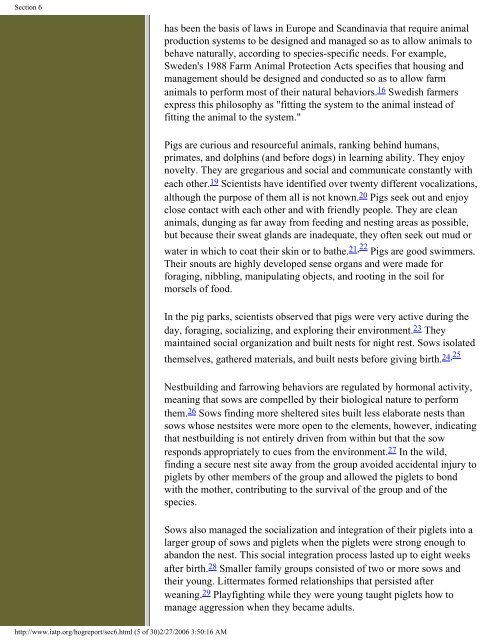IATP Hog Report - Institute for Agriculture and Trade Policy
IATP Hog Report - Institute for Agriculture and Trade Policy
IATP Hog Report - Institute for Agriculture and Trade Policy
Create successful ePaper yourself
Turn your PDF publications into a flip-book with our unique Google optimized e-Paper software.
Section 6<br />
has been the basis of laws in Europe <strong>and</strong> Sc<strong>and</strong>inavia that require animal<br />
production systems to be designed <strong>and</strong> managed so as to allow animals to<br />
behave naturally, according to species-specific needs. For example,<br />
Sweden's 1988 Farm Animal Protection Acts specifies that housing <strong>and</strong><br />
management should be designed <strong>and</strong> conducted so as to allow farm<br />
animals to per<strong>for</strong>m most of their natural behaviors. 16 Swedish farmers<br />
express this philosophy as "fitting the system to the animal instead of<br />
fitting the animal to the system."<br />
Pigs are curious <strong>and</strong> resourceful animals, ranking behind humans,<br />
primates, <strong>and</strong> dolphins (<strong>and</strong> be<strong>for</strong>e dogs) in learning ability. They enjoy<br />
novelty. They are gregarious <strong>and</strong> social <strong>and</strong> communicate constantly with<br />
each other. 19 Scientists have identified over twenty different vocalizations,<br />
although the purpose of them all is not known. 20 Pigs seek out <strong>and</strong> enjoy<br />
close contact with each other <strong>and</strong> with friendly people. They are clean<br />
animals, dunging as far away from feeding <strong>and</strong> nesting areas as possible,<br />
but because their sweat gl<strong>and</strong>s are inadequate, they often seek out mud or<br />
water in which to coat their skin or to bathe. 21,22 Pigs are good swimmers.<br />
Their snouts are highly developed sense organs <strong>and</strong> were made <strong>for</strong><br />
<strong>for</strong>aging, nibbling, manipulating objects, <strong>and</strong> rooting in the soil <strong>for</strong><br />
morsels of food.<br />
In the pig parks, scientists observed that pigs were very active during the<br />
day, <strong>for</strong>aging, socializing, <strong>and</strong> exploring their environment. 23 They<br />
maintained social organization <strong>and</strong> built nests <strong>for</strong> night rest. Sows isolated<br />
themselves, gathered materials, <strong>and</strong> built nests be<strong>for</strong>e giving birth. 24,25<br />
Nestbuilding <strong>and</strong> farrowing behaviors are regulated by hormonal activity,<br />
meaning that sows are compelled by their biological nature to per<strong>for</strong>m<br />
them. 26 Sows finding more sheltered sites built less elaborate nests than<br />
sows whose nestsites were more open to the elements, however, indicating<br />
that nestbuilding is not entirely driven from within but that the sow<br />
responds appropriately to cues from the environment. 27 In the wild,<br />
finding a secure nest site away from the group avoided accidental injury to<br />
piglets by other members of the group <strong>and</strong> allowed the piglets to bond<br />
with the mother, contributing to the survival of the group <strong>and</strong> of the<br />
species.<br />
Sows also managed the socialization <strong>and</strong> integration of their piglets into a<br />
larger group of sows <strong>and</strong> piglets when the piglets were strong enough to<br />
ab<strong>and</strong>on the nest. This social integration process lasted up to eight weeks<br />
after birth. 28 Smaller family groups consisted of two or more sows <strong>and</strong><br />
their young. Littermates <strong>for</strong>med relationships that persisted after<br />
weaning. 29 Playfighting while they were young taught piglets how to<br />
manage aggression when they became adults.<br />
http://www.iatp.org/hogreport/sec6.html (5 of 30)2/27/2006 3:50:16 AM

















